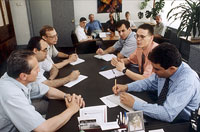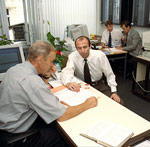
|
Presently summarizing the result of five years of work of the Eurasian Patent Office (EAPO), we are happy to conclude that EAPO has acquired a certain recognition and has secured a place in the world system of legal protection of inventions.
This fact is demonstrated by the yearly growth in the number of Eurasian applications and in the number of Eurasian patents granted.
Eurasian patent examination is the link between EAPO and the patent applicant. The world in general judges the level of this new international regional office by the quality of its examination.
Today's Eurasian patent examination is performed by a staff of qualified examiners who work under the guidelines of the Eurasian patent legislation and use progressive search technologies and automated systems.
Speaking of the EAPO examiners, we are happy to note that the staff of the Eurasian patent examination includes experts from all Eurasian Patent Convention (EAPC) member states.
In order to develop a common approach to examining Eurasian applications, and taking into consideration existing international practices, EAPO runs a special examiner preparation training course developed on the basis of the training course of the European Patent Office (EPO). While pursuing the objective of granting reliable Eurasian patents, EAPO at the same time meets another objective, that of training qualified specialists for the national patent offices of the EAPC member states.
Practically all EAPO examiners went through a training period in the EPO, a recognized leader among regional patent offices.
The newly hired examiners first work under the guidance of experienced mentors, i.e. examiners with extensive experience in patent examination acquired in national patent offices and in EAPO.

|
EAPO has developed and is using normative and methodological documents required for the examination; in particular, several provisions of the EAPC and of the Patent Regulations have been expanded, and the Rules of Drawing up, Filing and Processing of Eurasian Applications Office and the Regulations on the examination of Eurasian applications have been prepared.
Much attention is paid to the work with applicants and their representatives. For that purpose, EAPO holds regular meetings with Eurasian patent attorneys.
From the very first days of its existence EAPO has interacted with applicants in the mode of a friendly dialogue. The EAPO Bulletin contains methodological materials that explain the practical aspects of the Eurasian patent examination.
Eurasian patent legislation is one of the ingredients required for quality patent examination. The attractiveness of the Eurasian patent system on the whole depends on the extent to which Eurasian patent legislation matches the current worldwide tendencies in legal protection of inventions.
Scientific and technical progress requires constant improvements in the Eurasian patent legislation and its adaptation to the development of new areas of science and technology, such as genetic engineering, biotechnology, computer technology etc.

|
With that purpose EAPO is constantly working on improving Eurasian normative acts. In that regard, harmonization of patent legislation of EAPC member states is of major significance.
EAPO's success also depends on proper organization of the examination and of document processing. With that goal in mind significant work has been done during the last three years with the active participation of the European Patent Office towards the implementation in EAPO of the "Common Software" project, i.e. the automated information system for document processing. EAPO started using this System in its daily work this year in its pursuit of the goals of clear organization of the examination process on the basis of modern software and of a unified computer network. Examination quality of Eurasian applications depends on informational support.
It is known that EAPO started its activity in January of 1996 with very few examiners on its staff and with none of its own search capabilities or patent funds. At that transitional stage the EAPO examination was oriented towards making decisions with regard to Eurasian patents based on the information received from patent search reports prepared by other International Searching Authorities, of which the EPO and Rospatent are two. EAPO experience during the first five years indicates that such an approach makes sense.
According to the statistics compiled by EAPO, the major share of all Eurasian applications is comprised by international applications transferred to the regional phase according to the PCT procedure. About 90% of these applications, in addition to patent search reports, also contain the conclusion of the Preliminary International Examination. In order not to duplicate the work already performed by other International Searching Authority, EAPO presently orders additional searches in the Russian language fund of patent documentation and non-patent literature in Russia (including the USSR) and searches among the patent documentation of EAPC member states to Rospatent.
This way the EAPO examination results in a decision based on two patent search reports, thus partly applying in practice the idea of the so-called "supersearch".
Such methods in the EAPO examination correspond to the current trend of globalization of the patent system, one of the elements of which will certainly be mutual acceptance of patent search results by patent offices with equal examination capabilities.
With regard to the Eurasian applications that bypass the PCT procedure received by EAPO, decisions are made on the basis of full patent searches of the international type, which are performed by Rospatent as ordered by EAPO.
Thus we can confidently state that the Eurasian patent is a reliable legal document that effectively protects the interests of its owner.
At the same time EAPO intends to pursue the status of an International Searching Authority, its right to such a status being confirmed in the Eurasian Patent Convention. Even now the EAPO examiners have patent documentation on CD-ROM from WIPO IB, EPO, Germany, Japan, Austria, USA, Russia, and Great Britain. EAPO examiners have telecommunication access via a dedicated ISDN channel to patent information resources of EPO in Hague, and specifically to the EPOQUE-I and EPOQUE-II systems. All examiners are able to access the Internet information resources from their workplaces.
From 1998 EAPO has also been developing its own automated system of patent information (ASPI) intended for the formation and maintenance of electronic funds of patent and non-patent information, and information searches within these funds.
All this moves EAPO closer to being able to conduct examinations of Eurasian patent applications in full volume on the base its own patent searches.
Among other important objectives facing EAPO, the creation of an appeals body independent of patent examinations deserves a special mention. It will introduce balance into the current system of EAPO examinations, thus making the examination process more democratic and attractive to the applicants.